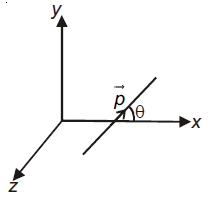Q. An electric dipole has a fixed dipole moment $\vec{p}$, which makes angles $\theta$ with respect to x-axis. When subjected to an electric field $\vec{E}_1 = E \hat{i}$, it experiences a torque $\vec{T}_1 = \tau \hat{k}$. When subjected to another electric field $\vec{E}_2 = \sqrt{3 E_1} \hat{j}$ it experiences a torque $\vec{T}_2 = - \vec{T}_1$. The angle $\theta$ is
Solution:
$\vec{p} = p \cos \theta \hat{i} + p \sin \theta \hat{j}$
$\vec{E}_1 = E \hat{i}$
$\vec{T}_1 = \vec{p} \times \vec{E}_1$
$ = (p \cos \theta \hat{i} + p \sin \theta \hat{j} ) \times E (\hat{i})$
$\tau \hat{k} = p E \sin \theta (- \hat{k})$ ......(i)
$\vec{E}_2 = \sqrt{3} E_1 \hat{j}$
$\vec{T}_2 = (p\cos \theta \hat{i} + p \sin \theta \hat{j} ) \times \sqrt{3} E_1 \hat{j}$
$ - \tau \hat{k} = \sqrt{3} p E_1 \cos \theta \hat{k}$ ....(ii)
From (i) and (ii)
$p E \sin \theta = \sqrt{3} pE \cos \theta$
$\tan \theta = \sqrt{3}$
$\theta = 60^{\circ}$
